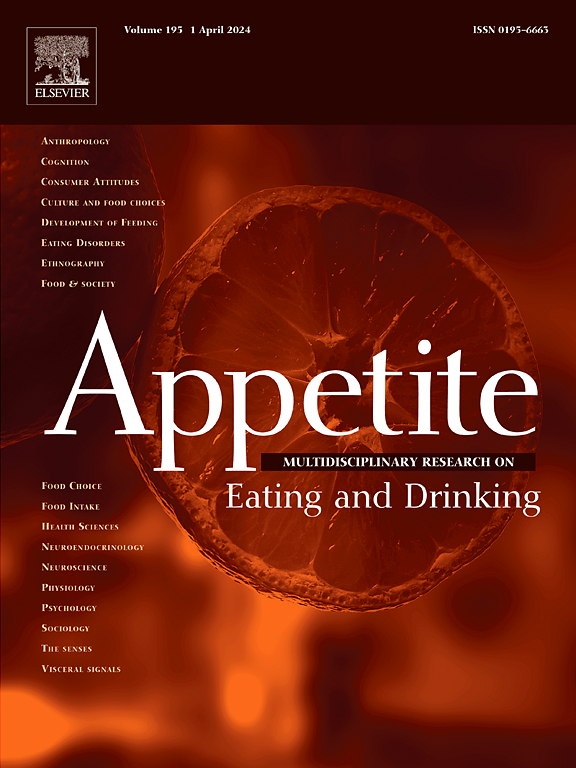环境因素对年轻人进食时食物摄入量的影响:混合效应分析。
IF 4.6
2区 医学
Q1 BEHAVIORAL SCIENCES
引用次数: 0
摘要
了解青壮年的饮食行为对于制定改善其饮食质量的策略至关重要。影响进食行为的因素往往是多方面的,而且与具体情况密切相关,但针对青壮年的研究却很少。本研究探讨了影响青壮年进食时食物摄入量的环境因素。参与者(n=675,18-30 岁)使用智能手机食物日记("FoodNow")记录了三至四天非连续进食场合(n=27,513)的饮食摄入量和环境特征。根据澳大利亚膳食指南,食物和饮料摄入量被分为六组。饮食场合层面的背景因素,如消费地点、购买地点、活动和社会背景,通过应用程序记录,而个人层面的背景因素则通过在线调查收集。采用随机截距的广义混合模型来研究环境因素对正餐和零食中食物种类消费的影响。进餐地点与蔬菜和随意食品的摄入量有关;与在家进餐相比,在途中进餐的蔬菜摄入量低 0.59 份(95% CI:-0.93, -0.38;p < 0.001),随意食品摄入量高 0.31 份(95% CI:0.03, 0.54;p = 0.014)。当有朋友在用餐和吃零食时,随意食品的摄入量更高(0.66 和 0.57 份,95% CI:0.56,0.88;0.36,0.77,p <0.001)。在便利店购买的膳食中,谷物和随意食品的含量高于在其他地点购买的膳食(P < 0.001)。大多数个人因素对食物类别消费的影响微乎其微。解决购买地点和正餐及零食时的社会环境等因素可能会改善食物选择,因为进食场合的微小变化会随着时间的推移对整体饮食质量产生重大影响。本文章由计算机程序翻译,如有差异,请以英文原文为准。
Contextual factors influence food intake at eating occasions in young adults: A mixed effect analysis
Understanding eating behaviours of young adults is crucial for developing strategies to improve their diet quality. Factors that influence eating behaviours are often multifaceted and highly contextual, with little research focused on young adults. This study examined contextual factors influencing food intake at eating occasions among young adults. Participants (n = 675, 18–30 years) recorded dietary intake and contextual characteristics at eating occasions (n = 27,513) using a smartphone food diary (“FoodNow”) over three to four non-consecutive days. Food and beverage intakes were classified into six groups according to the Australian Dietary Guidelines. Eating occasion-level contextual factors, such as consumption location, purchase location, activity, and social context, were recorded via the app, while person-level contextual factors were collected through an online survey. Generalised mixed models with random intercepts were used to investigate effects of contextual factors on food group consumption at meals and snacks. Eating location was associated with vegetable and discretionary food intake; meals that were eaten while in transit were 0.59 serves lower in vegetables (95% CI: −0.93, −0.38; p < 0.001) and 0.31 serves higher in discretionary foods (95% CI: 0.03, 0.54; p = 0.014), compared meals eaten at home. Higher intakes of discretionary foods were observed when friends were present at meals and snacks (0.66 and 0.57 serves, 95% CI: 0.56, 0.88; 0.36, 0.77, p < 0.001). Meals purchased from convenience stores were higher in grain and discretionary foods than meals from other locations (p < 0.001). Majority of person-level factors showed minimal effects on food group consumption. Addressing factors such as purchase location and social contexts during meals and snacks may improve food choices, as small changes at eating occasions can significantly impact overall diet quality over time.
求助全文
通过发布文献求助,成功后即可免费获取论文全文。
去求助
来源期刊

Appetite
医学-行为科学
CiteScore
9.10
自引率
11.10%
发文量
566
审稿时长
13.4 weeks
期刊介绍:
Appetite is an international research journal specializing in cultural, social, psychological, sensory and physiological influences on the selection and intake of foods and drinks. It covers normal and disordered eating and drinking and welcomes studies of both human and non-human animal behaviour toward food. Appetite publishes research reports, reviews and commentaries. Thematic special issues appear regularly. From time to time the journal carries abstracts from professional meetings. Submissions to Appetite are expected to be based primarily on observations directly related to the selection and intake of foods and drinks; papers that are primarily focused on topics such as nutrition or obesity will not be considered unless they specifically make a novel scientific contribution to the understanding of appetite in line with the journal's aims and scope.
 求助内容:
求助内容: 应助结果提醒方式:
应助结果提醒方式:


